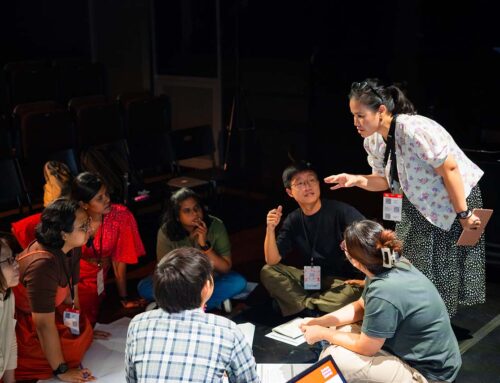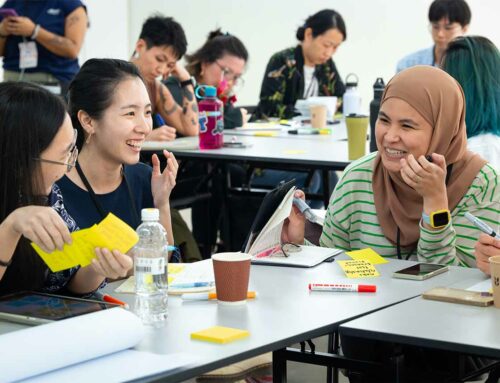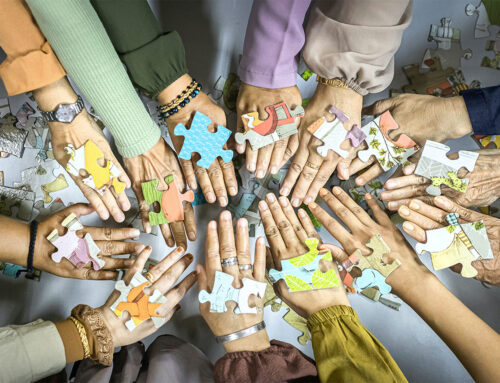Library / Field Studies
On Being Human, and Challenging One’s Boundaries When Working with Communities
Library / Field Studies
On Being Human, and Challenging One’s Boundaries When Working with Communities
An Interview with Han Xuemei
Fresh from her sabbatical last year, Han Xuemei joined us during our most recent Greenhouse Gathering to share more on her practice over the years, and her thoughts as the new Co-Artistic Director of Drama Box. Expanding on this, our Communication Manager Kirin Heng has interviewed her to learn more about the underlying philosophies that guide her work with communities.
Built into Xuemei’s practice with engaging communities is an innate sense of being human that forms the foundation to the relationships involved. She shares how a curiosity to constantly try out new things allows her to continue being inspired in her practice. To do this, she encourages immersing oneself in new environments or even returning to hobbies one is not proficient in. For instance, during her sabbatical, she tried out a wide range of new and old things.
The new – she learned squash from a new friend from gym, earned a certificate in fitness and training, assisted at Tak Takut Kids Club, and helped her friend out with kitchen work at her vegetarian food stall. The old – she edited a video, as a throwback to her time working at Mediacorp, taught a drama CCA again, shadowed another theatre practitioner’s rehearsal process, and project-coordinated an arts workshop.
Read on to discover Xuemei’s answers to our questions, her insights gathered over the years and more titbits of advice for practitioners starting out in this field!
What are some values that guide you when working with communities using theatre processes?
When I started leading my community-engaged projects, initially there would be this anxiety that there should be some kind of presentation or artwork. Over the years, one thing that I am learning to appreciate, and try to practise is how to be present. Being present encompasses a few things. It means listening to what a person [from the community] is telling you, versus keeping an ear out for how you want to frame it for your art project. Ultimately, the project is about what the people from the community are trying to say.
It’s not about revolving around artistic intent. It’s more the other way around, whereby when we work with communities, how do we understand what is going on in their lives, and then bring in the arts to organise or present some of these things that we understood in ways to allow more people to understand them.
Maybe listening is more like a skill set, which includes the ability to translate what you hear and what you get from being present with these communities, into something that can engage other people.
While it sounds cliché, a lot of artists may say we are first human beings, then we are artists, which to me is foundational. A simple way for me to put whatever I value into one sentence is: “how do we be human first?” Once we have that, then all the other things, such as the ethical concerns of respecting confidentiality, follow.

Xuemei (back row, third from right) with participants of The Gift, an artist-led workshop which was part of the Both Sides, Now 2017-2019 edition in Chong Pang. Photo credits: Zinkie Aw.
Another thing I learned is that “being human” is very different from just being nice. We have to be honest about this reality that we are not in this community to say “we just want to be friends with you”, but that we are here to make art with the community. What I’ve come to appreciate and learn over the years, is the importance of being very direct and honest about where you’re coming from. And even to share some of the curiosities and questions that you have in mind for the project, phrased in a way that people can understand.
Hence, when I first meet a community, it is first about getting to know one another. But at some point, I will also openly share about what I’m doing, and why I am here.
The point is being able to have this open and honest relationship with whomever you work with, which is related to the core of being human.
How important is artistic control in your work, especially when working with communities?
I see my role as depending on the project. For instance, in IgnorLAND, the goal is to make a performance, which revolves around the people, their stories, and whereby they are also part of the performance telling their own stories. Since the eventual form is a walking performance, it’s directed participation.
For projects like that, there is the need and responsibility on our end to hold that artistic space, because we are the ones who bring in this framing, which we invite them into if they’re willing to join. As artists, we have to retain the artistic eye and control in such situations [in order to be accountable to the community].
The question to ask is, what is the control for, and for whose sake? There’s another kind of artistic control whereby if it’s your individual project, and it’s just for individual expression, your accountability is to yourself.
But with a community-engaged project such as IgnorLAND, where we have artistic control, it actually serves the purpose of illustrating or telling some of these stories, such that others who are watching this can understand the complexity of the issues.
A very important skill and responsibility is artistic translation. It is not just simply about taking whatever people in the community have to say, and putting it out there with no mediation. But it is also ethical to make it very clear that there has been translation involved, and not to disguise it as actual.
For instance, [in the process of IgnorLAND], we talk to them, and then from there, gather ways to structure their stories; in order to make sense, and help people watching understand the issues. We then present [the resulting artistic work] back to them, asking questions such as, “Is this okay? Is this what you meant? Does this align with what you want to tell?” Hence a process of back-and-forth with them, such that what we eventually present would definitely be something that they are comfortable with.

Architect and community performer Jonathan Poh sharing about the architectural history and significance of Dakota Crescent at IgnorLAND of its Loss, a 2016 site-specific performance by Drama Box. Photo credits: The Pond Photography.
The main thing is that you need to know why you’re controlling or making certain artistic choices and who you’re making it for. Is it for your own ‘shiok-ness’? Is it to serve your ego? Or is it to make whatever stories that come out of the process retain their richness? To help clarify some things that come up in the work with the community? I think that is the question, the challenge.
Another way of approaching this is to question which one comes first. Do you go in with artistic control in mind? And then you try to find stories to fit inside your preconceived frame? Or do you go in to understand what’s going on first, and then you find a way to artistically frame these things? I think this makes a huge difference.
Because the former, where you go in with the artistic frame first, is too narrow. You end up selectively seeing and hearing things. Of course, sometimes your process needs to be like that, such as gathering research for a project on your own. For me, either might work, but it largely depends on the context, and in different projects with different intentions.
What motivates you personally to continue working with communities, versus becoming an artist working in silos and doing more of your personal projects?
Actually, what really drew me into doing theatre full-time was the whole experience with Drama Box [in their three-year youth theatre programme ARTivate], doing theatre in the heartlands, bringing it out to communities. And being able to see that the things that we were doing would resonate with people who might not normally buy a ticket to go watch theatre, people who might say, “Oh, theatre performance is very artsy fartsy” and not for them. But then [they come to our performances] and can engage with all these stories. For me, something that I’m very drawn towards is being able to talk directly with the people who are affected by the issues [we want to explore in our work].

Xuemei (third from left) performing in a forum theatre performance about censorship with ARTivate at Drama Box’s 2010 community tour Shh… Photo credits: Carol Sak.
I have also ventured into doing some other projects that require audiences to interact with the artworks, such as MISSING and FLOWERS. [I observed that] for those projects, it’s very obvious that they resonate with a certain demographic, and it requires a certain literacy, not just language, but artistic literacy, to engage with this type of introspective project.
The big question that I want to be answering is, how can the works we do really connect with, and really matter to people’s lives? So that they don’t have to exist on their own? I find that the most direct way for me to ensure this, is to remain connected with these people that I want to reach out to. This is a huge driving factor for me wanting to be ‘closer to the ground’ and really listen to what people are talking about, to what people are thinking and what people care about.
This is why being directly immersed in different spaces and different communities [which I started doing more of during my sabbatical], is hugely important for me because it helps me break out of the risk of remaining in this echo-chamber, and within this close circle in which everybody’s thinking the same way and talking about the same things.
When you work with communities using theatre and art practices, how would you describe this as art? Or defend it to people in the ‘Art’ world as art?
For me it’s about finding the essence of what theatre is and experimenting with the form. If I see theatre as being about the audiences experiencing things in visceral ways, it opens up a lot of possibilities. That’s how I define drama and performance at this point and what I want to experiment with more.
It is to understand that the black box is a tool, or a vocabulary, and not the definition of theatre.
Coming at community-engaged arts from the other extreme, some people might ask, why not just have another community worker doing this instead of bringing in an artist?
The immediate response is that I think the work should answer that question. From different experiences or things that I hear from my colleagues, I trust people can tell when the artworks are effective. Then the question of ‘why’ doesn’t come out. The art is not just there to enhance the exterior aesthetics.
The precious position that artists can take, especially with contentious or difficult issues, is that we can open spaces for the coexistence of diverse perspectives. I’m trying to not use the word “neutral” to describe our position, because I don’t think we are neutral and we always go in with some kind of perspective as well. But we can go in with a perspective, yet keep the space open. As a result, people may see the space as not one made to preach a certain message, but to dialogue about issues. I feel that the arts being able to do that is something that few stakeholders can do, because other parties might have something that they are holding on to.
For example, a social service agency might have a very specific cause they are focused on. That means that they may not be able or willing to expand beyond a certain boundary on contentious issues. Whereas for us, we are more interested in understanding the complexity. That’s also what differentiates the work that we can do. The position that we are in can allow us to have this potential to deal with very complex issues very openly. I think it always boils down to the question of how much we are allowed to push [boundaries]. This then depends on the context that we’re working in.
The other important thing that we do is we play, and we don’t stay at the cognitive, serious level. Our work is all about practising how to sense things around us differently, and in as creative a manner as possible. And this is something that we constantly practise. And so how do we bring that practice into the world of communities?

Xuemei (far left) observing a rehearsal at Drama Box.
One thing I observe about community and theatre is that it opens up the way people see the environment around them. This change in perspective may not result in changing their deeply rooted values or perspectives on serious issues. For example, even a simple theatre activity involves exercising a different muscle, a creative muscle. Artists have another way of understanding the world and doing things they can introduce to others, which I think is needed sometimes. Otherwise, we cannot have breakthroughs in some aspects of our lives, because we are too used to existing habits.
What kind of advice do you have for practitioners starting out in this field?
Don’t be anxious to start multiple projects on your own. It’s very humbling working with people, because you realise you cannot do so many things by yourself. Especially when you’re starting out, working with communities can be a very daunting and complex process. What I really found helpful for myself is to have a mentor. I had mentors, teachers at Drama Box, and I could follow their lead in some of these projects.
[When I was starting out], my focus was on how to have better conversations. And being able to observe on site how things are done, and how the conversations we have with people are translated into the eventual artistic medium. These are things I learned by assisting on projects instead of starting projects on my own. Working as part of a team is also a safety net, not [just] for yourself, but for the community.
Look out for opportunities to assist and to learn from practitioners, not just opportunities to present works. Especially in a climate now where there are grants for residencies and for projects to do your own work. Where making a livelihood is possible, look out for opportunities to assist, even if it’s unpaid.
During my sabbatical, I enjoyed being able to follow another person’s rehearsal process. And I intentionally chose someone who works very differently from me, just to see what other possibilities there are. This field of work is not just about changing the perspective of an audience, but also about changing your own perspective, by constantly or periodically putting yourself in situations where you normally wouldn’t be. Therefore, my advice is to keep finding opportunities to put yourself in new situations.

Xuemei was also active in Backalley Barbers, which offers free haircuts to migrant workers and the elderly.
I felt that in the years right before my sabbatical, I was becoming too cognitive and comfortable in one set way of working. That’s why I wanted to go do more on-the-ground or hands-on things. To tie this back to your question, it’s about knowing yourself, where you’re at, where you want to go, and then challenging yourself differently.
I always bear in mind this quote that I read in the book Engaging Performance. The writer mentioned hearing someone say: “an artist does many things on the way to becoming an artist. And you shouldn’t get stuck in one world, in this world that you’re used to.” This has always stayed with me: it’s always about putting yourself in situations you’re not used to. You’re constantly unlearning and ‘un-sticking’ yourself.
Cover Image: Xuemei (wearing blue shirt and cap) at a rehearsal with a resident and community performer for IgnorLAND of its Time, a 2014 site-specific performance at Bukit Ho Swee. Photo credits: Zinkie Aw.
Images provided by Han Xuemei, except otherwise mentioned.
About Han Xuemei

Han Xuemei (韩雪梅) is a theatre practitioner based in Singapore, and currently serves as the Co-Artistic Director of theatre company Drama Box. She believes in socially engaged practice, and imagines the arts as an integral ingredient for beauty and hope in society. Her artistic practice involves designing experiences, spaces and conditions for people to exercise their right to be creative, disrupt routines and deconstruct paradigms. She has conceptualised, directed, designed and facilitated numerous performances including FLOWERS (2019), The Gift (2018) and MISSING: The City of Lost Things (2018) — multi-disciplinary experiences that engage the audience in deeply visceral and personal ways. Xuemei was most recently awarded the 2021 Young Artist Award, Singapore’s highest award for young arts practitioners, by the National Arts Council.







